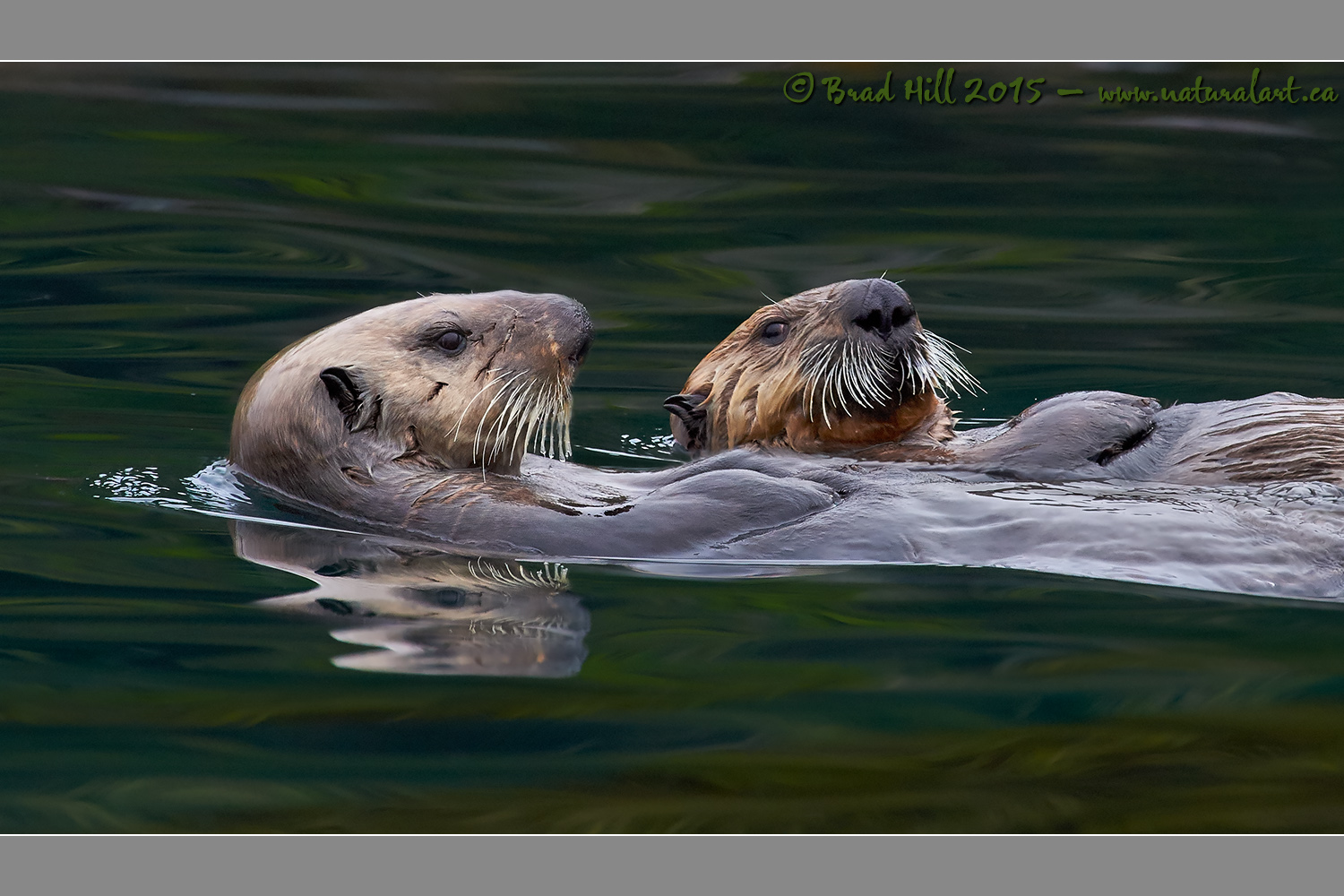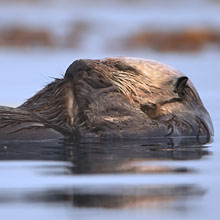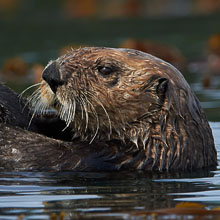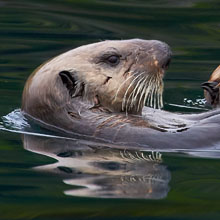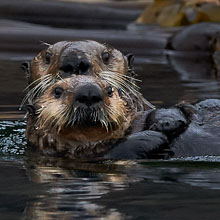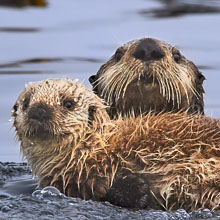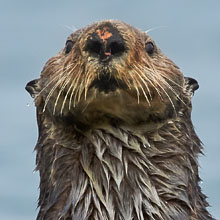Availability: Undetermined - Enquiries?
In the Field
Family Time. Northern Vancouver Island region, BC, Canada. August 13, 2015.
For the first six to eight months of their life young sea otters are fully dependent upon their mothers for all their needs. Most are born in the ocean and all are born with a thick fur coat that insulates them well. But in the first few weeks of life they are unable to swim and spend all of their time riding on their mothers chest and abdomen. When about one month old the pups start transitioning from a diet of milk over to solid seafood that mom dutifully delivers to them. By 5 months of age the young are diving and catching their own shellfish. And, by 6 to 8 months after the pup's birth mom is looking to ditch junior and find a new mate and begin the reproductive cycle all over again!
This shot shows a female sea otter swimming on the edge of a kelp forest with her almost-ready-to-wean pup. At this point the mother-offspring bond is still strong, and the otters remain in close contact, including a tremendous amount of touching (seconds before this shot junior was riding on mom's chest). Judging by the adoring look the pup is giving mom he (or she) probably has no idea that it won't be long before mom gives it the boot! Tough love coming real soon Junior - get ready for the real world!
When I looked at the raw version of this image what really grabbed my attention was the beautiful flowing reflections in the water. I captured this image using a Nikkor 400mm f2.8E VR lens combined with a TC-20EIII (2x) teleconverter. Used carefully (and with the right lenses) you can get very sharp shots out of this teleconverter with only minor degradation in image sharpness. But, I have noticed that with images captured with the 2x TC (and to a lesser degree with the 1.4x TC's) there is quite a bit of impact on the quality of the out-of-focus zones (i.e., on the bokeh). In most cases the out-of-focus (or OOF) zones captured when the 2x TC is used are "more jagged or jerky" and/or "nervous-looking" - and a whole lot less "smooth and buttery" - than if a good lens (like the 400mm f2.8E VR) is shot native. However, in this particular case, it appears that the teleconverter-induced bokeh "nervousness" has been softened somewhat by the uneven surface of the water, thus producing beautiful green streaked/banded reflections that look very painterly and actually ADD to the final image. Go figure, eh?
For those wishing to see this image larger, here's a higher-resolution (2400-pixel) version for your perusal:
• Family Time: Download 2400 pixel image (JPEG: 1.2 MB)
ADDITIONAL NOTES:
1. This image - in all resolutions - is protected by copyright. I'm fine with personal uses of it (including use as desktop backgrounds or screensavers on your own computer), but unauthorized commercial use of the image is prohibited by law. Thanks in advance for respecting my copyright!
2. Like all wildlife photographs on this website, this image was captured following the strict ethical guidelines described in The Wildlife FIRST! Principles of Photographer Conduct. I encourage all wildlife photographers to always put the welfare of their subjects above the value of their photographs.
3. This image was captured during my "Humpback, Orcas, Sea Lions & More" photo tour in August of 2015. Each year I offer trips into two different parts of the Great Bear Rainforest as well as one to photograph aquatic mammals and oceanscapes near the northern tip of Vancouver Island. And, in selected years, I also offer photo tours to locations to capture other highly sought-after subjects, such as various owl species of the boreal forest and wildlife of Canada's Arctic. Details about these trips can be found on the Photo Tours page of this website.
Behind the Camera
Family Time. Northern Vancouver Island region, BC, Canada. August 13, 2015.
Digital Capture; Compressed RAW (NEF) 14-bit format; ISO 4500.
Nikon D4s paired with Nikkor 400mm f2.8E VR plus TC-20EIII (2x) teleconverter (800mm total focal length). Hand-held from floating Zodiac, VR on and in "Sport" mode.
1/1000s @ f9; -0.67 stop compensation from "recommended" matrix-metered exposure setting.
At the Computer
Family Time. Northern Vancouver Island region, BC, Canada. August 13, 2015.
RAW Conversion to 16-bit TIFF using Phase One's Capture One Pro 8. Three raw variants (different versions of a single raw capture) processed, with the variants differing in exposure (0.3 stop total difference between the variants) and in noise reduction settings.
Further digital corrections on resulting 16-bit TIFF files using Adobe's Photoshop CC 2015 and Light Crafts Lightzone. Photoshop adjustments included compositing (blending) of the three output files from the raw converter, several minor selective exposure adjustments, minor selective colour saturation and desaturation, selective contrast adjustment via selective curves adjustment, and selective sharpening for web output. Final tone-tweaking performed using LightZone's "tonemapper" tool.
Conservation
Family Time. Northern Vancouver Island region, BC, Canada. August 13, 2015.
Ten percent of the revenue generated by this image will be donated to Raincoast*.
Species Status in Canada**: Special Concern (April 2007) - protected off the North American coast since 1911.
Back in the late 1800's and early 1900's the Sea Otter (Enhydra lutris) was hunted to near extinction along both the Asian and North American Pacific Coasts. The reason? It's luxuriant coat. Otters are unlike any other aquatic mammal in that they don't use fat or blubber to insulate themselves from the chilling effects of the water they are found in. Instead, they rely on their amazingly thick fur coat for insulation. Their amazing coats have a higher density of hair (up to 150,000 strands of hair per square cm!) than any other animal in existence today. To ensure that this coat serves its insulative purpose, otters spend a disproportionately large amount of time grooming their coat (to ensure its natural oils continue to provide an effective waterproof barrier). Unfortunately, the biological functioning of the otters coat can be easily fouled by contamination by oil and other hydrocarbons - thus making them extremely sensitive to the effective of marine oil spills.
Other fascinating aspects of the biology and behaviour of the sea otter include the use of tools (they will use rocks to break apart shellfish such as sea urchins), and the fact that they have an metabolic rate two to three times higher than other mammals of their size. This means they must eat 23% to 33% of their own body weight DAILY, just to to replace the calories burned through maintaining their body temperature in the cold water environment they live in.
*The Raincoast Conservation Society (and Foundation) is an effective and efficient organization that has been fighting for protection of this unique habitat. If you are looking for a meaningful way to contribute to the conservation of this amazing ecosystem, Raincoast will provide maximal "bang" for your conservation dollars.
**as determined by COSEWIC: The Committee on the Status of Endangered Wildlife in Canada












